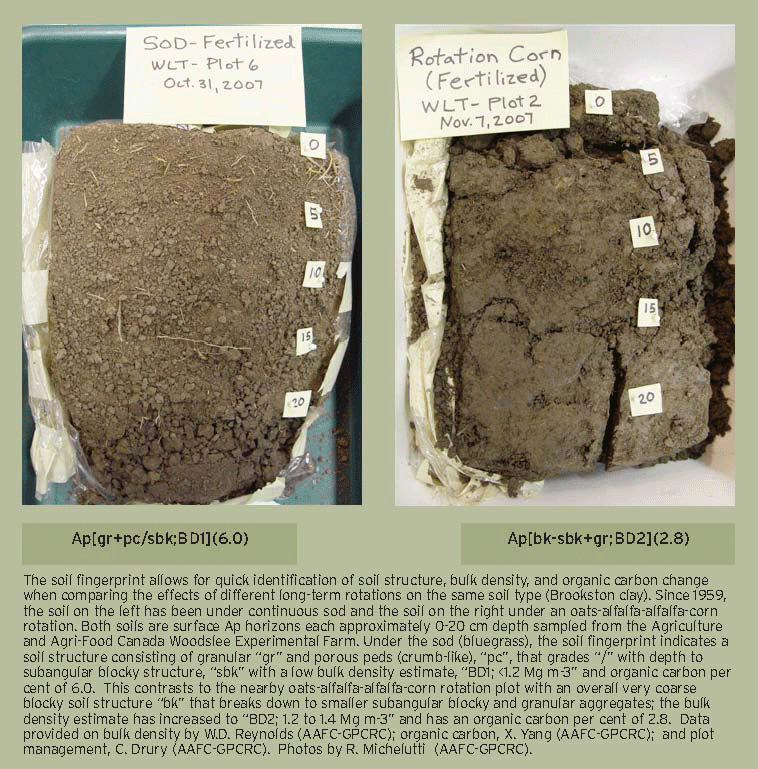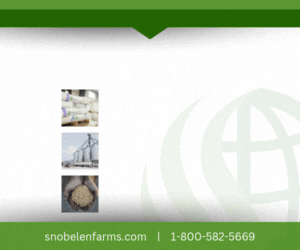Soil fingerprinting
MONITORING CHANGES IN SOIL QUALITY
THERE ARE THREE reasons you should get to know your soil better – higher yields, better soil quality, and a better understanding of land management practices. A research team at Agriculture and Agri-Food Canada (AAFC) says it is easier to achieve all of these with the ability to accurately monitor changes in soil quality and they have developed an internationally transferable system to fingerprint soil.

No two fingerprints are the same and it is no different for soil. Natalie Feisthauer, project co-lead and land resource scientist with the AAFC Knowledge and Technology Transfer Office in Ontario, says many different topsoil properties not only vary across fields but are constantly changing too, making it difficult to monitor changes in soil quality. A group of researchers, originally led by AAFC research scientist Dr. Catherine Fox, have developed a methodology called the A Horizon Framework for recording detailed characteristics of the surface layer of the soil that generates a soil fingerprint.
MEASURING FARM METHODS
“The A Horizon is the topsoil, or surface layer of the soil,” explains Feisthauer. “This portion of the soil is dynamic, with properties constantly changing making it difficult to describe in a concise way.”
That is why the AAFC team came up with the idea to find a way to record, monitor, and compare changes in the soil. The result is a Framework, or method, to describe and track dynamic soil properties important to soil quality like soil structure, pH, the level of organic matter, bulk density, and electrical conductivity. The results, or soil fingerprints, can be easily compared across a field or geographic region and over time to monitor changes and assess the impacts of production practices on soil.
“With this system. a farmer can measure the impact of conservation tillage by comparing the changes, among fingerprints, of a characteristic like bulk density, or the extent of soil compaction,” says Feisthauer. “Our goal is to provide the agriculture community with a useful tool to assist in evaluating the effectiveness of best management practices on soil quality.”
The Framework can be used to monitor and track changes to soil characteristics among fields or multiple areas within a field, helping farmers evaluate and diagnose problem areas or measure overall production practices by checking for changes to soil characteristics important to soil quality. Tracking and comparing soil fingerprints over a period of time provides farmers information about whether or not their production practices are affecting their soil. Some changes in soil fingerprints can be seen as quickly as within a single growing season.
Soil fingerprints are created by following the Framework (or methodology) for recording detailed characteristics of the surface layer of the soil. This has been automated by being able to directly input data into a specially designed electronic field form. Soil fingerprints, generated for individual soil samples collected as part of a field or landscape soil assessments, are used to monitor changes during the growing season and/or over several years spatially within fields or between sites. Multiple soil fingerprints can easily be compared, just like comparing our own fingerprints or DNA, explains Feisthauer.
An electronic field form has been developed to partially automate the process of generating soil fingerprints and includes drop down icons (and information boxes) for each soil category to allow information to be easily entered into the spreadsheet with a single line representing the fingerprint of the soil sample from a field or soil area being assessed.
“The result is a snapshot of the soil’s characteristics at the time of the sample,” says Feisthauer. And the more fingerprints collected the more information the system can use to generate comparisons and results.
The field form is designed to be used in the office or out in the field. “You can be as long and detailed or as short and general as you want when inputting data into the field form,” says Feisthauer.
The Framework is designed so properties that aren’t of interest to the user can be ignored and new properties that might be of interest (e.g. cropping history, number of earthworms, etc.) can be added. Lab results from soil samples can be easily included in a fingerprint for any given soil characteristic, resulting in very precise information. Each fingerprint is a single line of codes and symbols that describes the status of the soil characteristics at the time the soil was sampled. Though it won’t prescribe the health of the soil, the information will help farmers understand and apply the findings to their operation.
“The Framework has been designed to be practical, flexible, and with training, easy to use,” assures Feisthauer.
INTERNATIONAL COLLABORATION
The A Horizon Framework has been in the making for six years. Fox, based at AAFC Harrow, recognized the need to provide enhanced soil description designators and a framework to document the dynamic soil changes in the A Horizon to distinguish and monitor subtle soil property changes occurring when implementing best management practices. The Framework was developed by Fox and AAFC soil scientists Charles Tarnocai, David Kroetsch and Elizabeth Kenney, as well as international collaborators from Germany, Drs. Gabriele Broll and Monika Joschko.
Fox has since retired, but the work of the research team continues to enhance the Framework for use on farms and with different farm management practices. The project, now led by Feisthauer and project co-lead David Kroetsch from the AAFC Eastern Cereals and Oilseeds Research Centre in Ottawa, work together with Ontario collaborators testing the Framework in long term field plots in Ontario
and Germany.
The team continues to work with their international partners who are assessing the use of the Framework under different soils and agronomic systems. These collaborations will help ensure the Framework and soil fingerprinting results integrate the requirements of other national and international soil taxonomy protocols for describing soils, so the system can be adopted internationally.
The current focus of the project is transferring the technology to an in-field application. Currently, AAFC and project partners from the Ontario Ministry of Agriculture, Food and Rural Affairs and the University of Guelph are field testing the applicability and logistics of using the Framework and field form. A major focus of the project is developing guidance materials to help non-soil specialists use the Framework so that both specialists and non-specialists alike can properly interpret the results. The team hopes to conduct field trials with Ontario farmers within the next two years and host workshops and demonstrations of the Framework.
“Everyone works for sustainable use of our soils,” says Feisthauer. “Healthy soils mean a healthy future and no one knows that better than farmers. We expect the soil fingerprinting Framework will be a new tool to help farmers monitor the changes to soil properties with the aim towards providing them with detailed information for making decisions on improving soil quality in their fields.” •

















